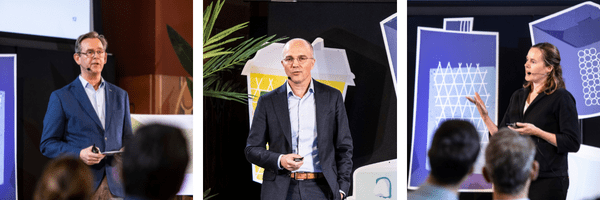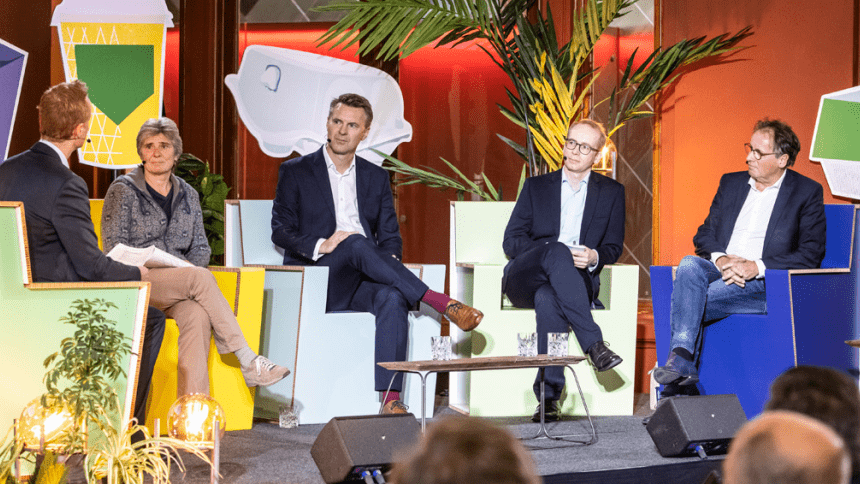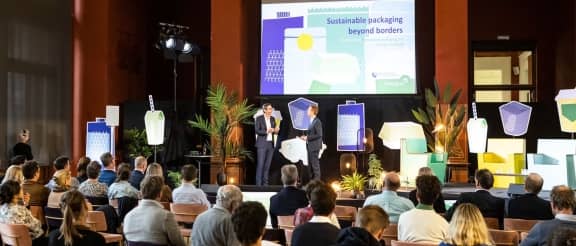KIDV continues as Verpact
November 6, 2025
From plastic to paper, that seems to be an easy step to make packaging more sustainable. This shift has been clearly visible for several years. Companies with sustainable packaging goals score a lot of goodwill with consumers. And because of its high recycling rate (90 per cent in the Netherlands and 92 per cent in Belgium), paper and cardboard packaging seem to make a major contribution to the circular packaging chain. But we should not close our eyes to the limitations and boundaries of fibre-based packaging.
This emerged at the KIDV and Fost Plus seminar 'The future of fibre-based packaging in the circular economy' on 17 November last. Both organisations had invited several experts to discuss the current status on the collection, sorting and recycling of paper and cardboard in the Netherlands and Belgium. Coen Bertens of the Packaging Waste Fund (Afvalfonds Verpakkingen) explained the Dutch practice and results. In our country, and in recent years, the stream of collected waste paper and cardboard grew each year. The share of packaging waste in this stream rose sharply, with 4% each year in the last 4 years, partly because many products are now being ordered online due to corona. Bertens: "The Packaging Waste Fund does not interfere with the paper and cardboard packaging recycling. Both municipalities and companies have their own contracts with collectors and waste companies and the prices of paper and cardboard are good. So actually, this is already a good example of a circular economy." Beverage cartons, however, do not count in this stream. The recycling rate (31 per cent) lags behind other streams. "That will improve when a separate recycling target for beverage cartons will apply in 2023," Bertens expects.
Belgium has the ambition to recycle 100 per cent of all its packaging materials. Our southern neighbours are at 92 per cent with paper and cardboard and 73 per cent with beverage cartons, said Mik Van Gaever of Fost Plus. The Belgian approach is based on design-for-recycling guidelines, which puts companies on track to design packaging in such a way that it fits well into the existing sorting and recycling infrastructure. The better they do this, the less they have to contribute to paying for recycling. "Ultimately, through optimisation and innovations, we want to get to a 100 per cent score. For this, we are specifically also looking at the flow of on-the-go packaging and the impact of reuse."
The design-for-recycling guidelines in the Netherlands ('translated' into the KIDV Recyclecheck for paper and cardboard packaging) and Belgium are very similar, according to an overview of differences and similarities between the Netherlands and Belgium presented by Annemarie Abbeel (Fost Plus). Both countries have their own criteria for paper or cardboard packaging. In Belgium, the fibre component must then be at least 85 per cent, while in the Netherlands it is at least 50 per cent. For recycling rates (high in both countries), such differences do not matter much. "But more and more alternative fibre packaging is emerging," says Abbeel. "Of materials with other fibre bases, the question is what the actual recovery rate will be. That could affect the recycling results."

The variety of fibre-based packaging is indeed growing, and not all of them perform equally well on circularity. As mentioned, the Netherlands and Belgium score well at 90 and 92 per cent, but European averages 75 per cent. The goal of CEPI, which represents the interests of the European paper industry, is to increase the overall recycling rate of fibre-based packaging to 90 per cent by 2030. The 4evergreen project has set four interim targets for 2025. Programme director Susanne Haase explained these in detail during the seminar.
4evergreen previously drew up a test protocol for paper mills to assess the recyclability of their products. An evaluation protocol will soon follow which will allow test results to be quantified and compared. "With this, we will clarify which fibre-based materials can be recycled with which technology. It gives the industry insight into how to make packaging as sustainable as possible from the design phase to recycling," Haase said. The evaluation protocol will then contribute to the development of specific circularity guidelines and improved collection and sorting. The evaluation protocol is expected to be delivered within a few months.
In the second part of the seminar, Karine Van Doorsselaar (University of Antwerp), Rob Hoitink (Nestlé), Peter Hengesbach (Stora Enso) and KIDV director Chris Bruijnes debated the current popularity of fibre-based packaging and their contribution to a sustainable, circular packaging chain. For Nestlé, they play an important role in its approach to reduce plastic use, Hoitink said. Hengesbach added that consumers like them instead of plastic packaging, to which Van Doorsselaar responded. "Consumers always immediately think of sustainability when they think of paper, but they don't delve into the details to assess it properly. They often cannot distinguish between different layers of material. I therefore believe that a company should not simply base its choice of one material type or another on consumer behaviour."

"Instructions on packaging should be clear, although again it is difficult to communicate because different provisions apply in each country," Hoitink felt. But then again... Chris Bruijnes demonstrated with two sample packages how difficult and how hard it is for consumers, to take apart multi-layer packaging of different materials and properly dispose of each part of the packaging. "That's really too much to ask; it just doesn't happen in practice," he said. Van Doorsselaar: "I don't believe in it either. So that's why you shouldn't shift the responsibility to consumers; the legislator should take it."
Challenges also lie in the area of coffee and/or soup cups and beverage cartons. Deposit cups, chemical recycling and reuse systems were mentioned as possible solutions to various problems. And infrastructure needs to be in place. "Let's not think that paper is a solution for everything. It cannot replace all plastic in packaging, because of the functionalities required," Hengesbach said. Van Doorsselaar: "Besides, we don't even have enough trees in the whole world for that."
"Paper and cardboard packaging deserve a chance," judged Bruijnes at the end of the meeting. He argued - in view of the approaching updates to the European directives on packaging and packaging waste - to give the industry enough room for action. "Don't let Europe impose everything in laws and regulations. To close and prescribe everything is disastrous for innovation."
You can watch the seminar by clicking on the video below.
